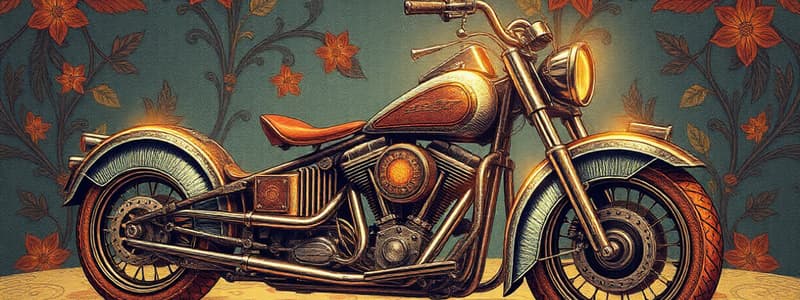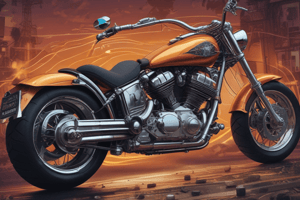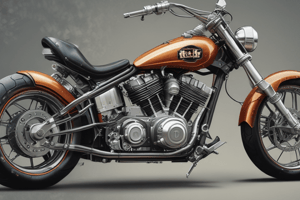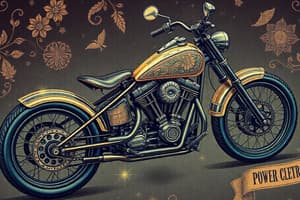Podcast
Questions and Answers
What distinguishes a DC chopper from an AC link chopper?
What distinguishes a DC chopper from an AC link chopper?
- AC link choppers do not use transformers, while DC choppers do.
- DC choppers are designed to decrease voltage only, while AC link choppers can increase voltage.
- DC choppers convert AC to AC while AC link choppers convert DC to DC.
- DC choppers execute single-stage conversion while AC link choppers follow a two-stage conversion. (correct)
In which scenario are chopper circuits particularly necessary?
In which scenario are chopper circuits particularly necessary?
- When the input voltage is already variable DC.
- When devices require variable DC input from a fixed AC supply. (correct)
- When AC voltage must be directly stepped down to another AC voltage.
- When the output should be a fixed DC voltage regardless of input.
What is a primary characteristic of the two types of DC to DC conversion techniques?
What is a primary characteristic of the two types of DC to DC conversion techniques?
- Both types are equally efficient in all applications.
- AC link choppers involve higher costs and inefficiency due to two conversion stages. (correct)
- AC link choppers can only step down voltage, while DC choppers can only step up.
- DC choppers utilize transformers while AC link choppers do not.
What type of control strategies can be used in DC choppers?
What type of control strategies can be used in DC choppers?
Why can chopper circuits be compared to AC transformers?
Why can chopper circuits be compared to AC transformers?
What does the term 'static power electronics device' imply in the context of DC choppers?
What does the term 'static power electronics device' imply in the context of DC choppers?
What might be a disadvantage of using an AC link chopper compared to a DC chopper?
What might be a disadvantage of using an AC link chopper compared to a DC chopper?
How does the output voltage behavior in DC choppers change?
How does the output voltage behavior in DC choppers change?
What is the primary function of a transformer in an AC link chopper circuit?
What is the primary function of a transformer in an AC link chopper circuit?
What is the duty cycle in the context of time ratio control?
What is the duty cycle in the context of time ratio control?
Which control strategy keeps the frequency constant while varying ON time?
Which control strategy keeps the frequency constant while varying ON time?
What is a significant disadvantage of frequency modulation (FM) in control systems?
What is a significant disadvantage of frequency modulation (FM) in control systems?
How does current limit control function in a DC to DC converter?
How does current limit control function in a DC to DC converter?
What occurs when the auxiliary thyristor TA is triggered after the capacitor has charged?
What occurs when the auxiliary thyristor TA is triggered after the capacitor has charged?
What characterizes voltage-commutated chopper circuits?
What characterizes voltage-commutated chopper circuits?
During which time period does the commutation current ic reach its maximum value?
During which time period does the commutation current ic reach its maximum value?
What is forced commutation in the context of thyristors?
What is forced commutation in the context of thyristors?
What happens to a thyristor during load commutation?
What happens to a thyristor during load commutation?
What is the load voltage V0 at instant t2 after both the load voltage and the capacitor voltage are accounted for?
What is the load voltage V0 at instant t2 after both the load voltage and the capacitor voltage are accounted for?
What is the relationship between the capacitor voltage Vc and the voltage across the auxiliary thyristor TA at the point when the load voltage is Vdc?
What is the relationship between the capacitor voltage Vc and the voltage across the auxiliary thyristor TA at the point when the load voltage is Vdc?
Which of the following describes pulse width modulation (PWM) correctly?
Which of the following describes pulse width modulation (PWM) correctly?
What critical component is used in the voltage-commutated chopper circuit for protection against inductive loads?
What critical component is used in the voltage-commutated chopper circuit for protection against inductive loads?
Which component maintains the voltage –Vs constant during the operation of the chopper?
Which component maintains the voltage –Vs constant during the operation of the chopper?
Which of the following statements about time ratio control is true?
Which of the following statements about time ratio control is true?
What is a defining characteristic of a step-down chopper compared to a step-up chopper?
What is a defining characteristic of a step-down chopper compared to a step-up chopper?
What happens to the load voltage V0 as the capacitor begins to discharge through the load?
What happens to the load voltage V0 as the capacitor begins to discharge through the load?
What is the primary function of an AC chopper in a circuit?
What is the primary function of an AC chopper in a circuit?
What defines the operation of a voltage commutated chopper?
What defines the operation of a voltage commutated chopper?
What is not considered a standard chopper type in power electronics?
What is not considered a standard chopper type in power electronics?
What distinguishes the efficiency of a DC chopper from that of an AC link chopper?
What distinguishes the efficiency of a DC chopper from that of an AC link chopper?
What is the primary role of the diode rectification unit in an AC link chopper?
What is the primary role of the diode rectification unit in an AC link chopper?
Which of the following statements about time ratio control in DC choppers is correct?
Which of the following statements about time ratio control in DC choppers is correct?
In what way do chopper circuits provide adjustable DC power according to requirements?
In what way do chopper circuits provide adjustable DC power according to requirements?
Why is the AC link chopper considered less efficient compared to the DC chopper?
Why is the AC link chopper considered less efficient compared to the DC chopper?
How do applications requiring power from DC voltage sources relate to chopper circuits?
How do applications requiring power from DC voltage sources relate to chopper circuits?
What might be a consequence of using a transformer in an AC link chopper?
What might be a consequence of using a transformer in an AC link chopper?
What is a significant feature of a static power electronics device like a DC chopper?
What is a significant feature of a static power electronics device like a DC chopper?
Which characteristic defines the average output voltage in both control strategies of DC choppers?
Which characteristic defines the average output voltage in both control strategies of DC choppers?
What defines the operation of current limit control in a DC to DC converter?
What defines the operation of current limit control in a DC to DC converter?
Which of the following statements accurately describes load commutation?
Which of the following statements accurately describes load commutation?
In the context of voltage-commutated choppers, which statement is correct?
In the context of voltage-commutated choppers, which statement is correct?
What is a disadvantage associated with variable frequency operation in DC choppers?
What is a disadvantage associated with variable frequency operation in DC choppers?
What is the primary advantage of using pulse width modulation (PWM) over frequency modulation in DC-DC converters?
What is the primary advantage of using pulse width modulation (PWM) over frequency modulation in DC-DC converters?
What role does the capacitor play in the operation of a voltage-commutated chopper?
What role does the capacitor play in the operation of a voltage-commutated chopper?
During frequency modulation, which of the following occurrences is expected?
During frequency modulation, which of the following occurrences is expected?
What happens to the load current when the DC-DC converter turns OFF during current limit control?
What happens to the load current when the DC-DC converter turns OFF during current limit control?
Which component is crucial for the functioning of voltage-commutated chopper circuits to avoid inductive load issues?
Which component is crucial for the functioning of voltage-commutated chopper circuits to avoid inductive load issues?
What primarily differentiates forced commutation from load commutation?
What primarily differentiates forced commutation from load commutation?
What occurs to the main thyristor TM when the auxiliary thyristor TA is triggered?
What occurs to the main thyristor TM when the auxiliary thyristor TA is triggered?
During which time period does the commutation current ic reach its maximum value?
During which time period does the commutation current ic reach its maximum value?
How does the operation of a step-up chopper differ from that of a step-down chopper?
How does the operation of a step-up chopper differ from that of a step-down chopper?
What defines the behavior of the load voltage V0 during the discharge of the capacitor through the load?
What defines the behavior of the load voltage V0 during the discharge of the capacitor through the load?
In a voltage-commutated chopper, what maintains the load current's flow after TM is turned off?
In a voltage-commutated chopper, what maintains the load current's flow after TM is turned off?
What is the significance of the voltage across the capacitor in the context of voltage-commutated choppers?
What is the significance of the voltage across the capacitor in the context of voltage-commutated choppers?
How is the auxiliary thyristor TA affected after the capacitor becomes fully charged?
How is the auxiliary thyristor TA affected after the capacitor becomes fully charged?
What role does the diode D play in the circuit described for the voltage-commutated chopper?
What role does the diode D play in the circuit described for the voltage-commutated chopper?
What is the principal difference in functionality between an AC chopper and a step-up chopper?
What is the principal difference in functionality between an AC chopper and a step-up chopper?
Flashcards
Chopper Circuit
Chopper Circuit
Electronic circuits that convert a fixed DC voltage to a variable DC voltage.
DC to DC Converter
DC to DC Converter
A device that converts a fixed DC voltage to a variable DC voltage.
AC Link Chopper
AC Link Chopper
A two-stage DC-to-DC converter that first converts DC to AC, then AC to DC, using an inverter and transformer.
DC Chopper
DC Chopper
Signup and view all the flashcards
Time Ratio Control
Time Ratio Control
Signup and view all the flashcards
Current Limit Control
Current Limit Control
Signup and view all the flashcards
Need for DC-DC Conversion
Need for DC-DC Conversion
Signup and view all the flashcards
Static Power Electronics Device
Static Power Electronics Device
Signup and view all the flashcards
Fixed DC input
Fixed DC input
Signup and view all the flashcards
Variable DC output
Variable DC output
Signup and view all the flashcards
Time Ratio Control
Time Ratio Control
Signup and view all the flashcards
Constant Frequency Operation
Constant Frequency Operation
Signup and view all the flashcards
Variable Frequency Operation
Variable Frequency Operation
Signup and view all the flashcards
Current Limit Control
Current Limit Control
Signup and view all the flashcards
Voltage-Commutated Chopper
Voltage-Commutated Chopper
Signup and view all the flashcards
Commutation
Commutation
Signup and view all the flashcards
Forced Commutation
Forced Commutation
Signup and view all the flashcards
Voltage Commutation
Voltage Commutation
Signup and view all the flashcards
Load Commutation
Load Commutation
Signup and view all the flashcards
Duty Cycle
Duty Cycle
Signup and view all the flashcards
Voltage Commutated Chopper
Voltage Commutated Chopper
Signup and view all the flashcards
Charging Capacitor Methods
Charging Capacitor Methods
Signup and view all the flashcards
Chopper Operation
Chopper Operation
Signup and view all the flashcards
Step-up Chopper
Step-up Chopper
Signup and view all the flashcards
Step-down Chopper
Step-down Chopper
Signup and view all the flashcards
AC Chopper
AC Chopper
Signup and view all the flashcards
Jones Chopper
Jones Chopper
Signup and view all the flashcards
Load Current (i0)
Load Current (i0)
Signup and view all the flashcards
Commutation Current (ic)
Commutation Current (ic)
Signup and view all the flashcards
Commutation
Commutation
Signup and view all the flashcards
Chopper Circuit (Definition)
Chopper Circuit (Definition)
Signup and view all the flashcards
AC Link Chopper
AC Link Chopper
Signup and view all the flashcards
DC Chopper (Type)
DC Chopper (Type)
Signup and view all the flashcards
Need for DC-DC Conversion
Need for DC-DC Conversion
Signup and view all the flashcards
Time Ratio Control
Time Ratio Control
Signup and view all the flashcards
Duty Cycle
Duty Cycle
Signup and view all the flashcards
Current Limit Control
Current Limit Control
Signup and view all the flashcards
Fixed DC Input
Fixed DC Input
Signup and view all the flashcards
Variable DC Output
Variable DC Output
Signup and view all the flashcards
Static Power Electronics Device
Static Power Electronics Device
Signup and view all the flashcards
Time Ratio Control
Time Ratio Control
Signup and view all the flashcards
Constant Frequency Operation
Constant Frequency Operation
Signup and view all the flashcards
Variable Frequency Operation
Variable Frequency Operation
Signup and view all the flashcards
Current Limit Control
Current Limit Control
Signup and view all the flashcards
Voltage Commutated Chopper
Voltage Commutated Chopper
Signup and view all the flashcards
Commutation
Commutation
Signup and view all the flashcards
Forced Commutation
Forced Commutation
Signup and view all the flashcards
Duty Cycle
Duty Cycle
Signup and view all the flashcards
Load Commutation
Load Commutation
Signup and view all the flashcards
DC-DC Converter Applications
DC-DC Converter Applications
Signup and view all the flashcards
Voltage-Commutated Chopper
Voltage-Commutated Chopper
Signup and view all the flashcards
Charging Capacitor Methods
Charging Capacitor Methods
Signup and view all the flashcards
Commutation Current (ic)
Commutation Current (ic)
Signup and view all the flashcards
Load Current (i0)
Load Current (i0)
Signup and view all the flashcards
Step-up Chopper
Step-up Chopper
Signup and view all the flashcards
Step-down Chopper
Step-down Chopper
Signup and view all the flashcards
AC Chopper
AC Chopper
Signup and view all the flashcards
Jones Chopper
Jones Chopper
Signup and view all the flashcards
Commutation
Commutation
Signup and view all the flashcards
Voltage Commutation
Voltage Commutation
Signup and view all the flashcards





